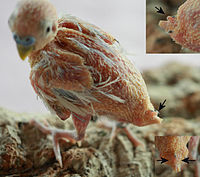
Preen gland of the laughing dove (Streptopelia senegalensis aegyptiaca): Light and electron microscopic analysis.
Sign Up to like & getrecommendations! Published in 2023 at "Microscopy research and technique"
DOI: 10.1002/jemt.24313
Abstract: This work reviews the microscopic anatomy of the preen gland in laughing dove (Streptopelia senegalensis aegyptiaca) using light, scanning, and transmission electron microscopes. The gland possessed two large pea-shaped lobes. The glandular lobules of each… read more here.
Keywords: dove streptopelia; microscopy; gland laughing; laughing dove ... See more keywords

Global Monitoring of Persistent Organic Pollutants (POPs) Using Seabird Preen Gland Oil
Sign Up to like & getrecommendations! Published in 2018 at "Archives of Environmental Contamination and Toxicology"
DOI: 10.1007/s00244-018-0557-3
Abstract: Situated at high positions on marine food webs, seabirds accumulate high concentrations of persistent organic pollutants (POPs), such as polychlorinated biphenyls (PCBs), dichlorodiphenyltrichloroethane and its metabolites (DDTs), and hexachlorocyclohexanes (HCHs). Our previous studies proposed the… read more here.
Keywords: preen gland; gland oil; organic pollutants; persistent organic ... See more keywords

Lack of access to an open water source for bathing inhibited the development of the preen gland and preening behavior in Sanshui White ducks
Sign Up to like & getrecommendations! Published in 2020 at "Poultry Science"
DOI: 10.1016/j.psj.2020.08.018
Abstract: As a species of waterfowl, ducks rely on access to water to facilitate feeding behaviors. Further, wet preening behavior in ducks relies on access to water and is a key behavior for duck welfare. Traditionally,… read more here.
Keywords: open water; water; group; preen gland ... See more keywords

Effects of genotype, sex, and feed restriction on the biochemical composition of chicken preen gland secretions and their implications for commercial poultry production
Sign Up to like & getrecommendations! Published in 2022 at "Journal of Animal Science"
DOI: 10.1093/jas/skac411
Abstract: Abstract Preen gland secretions spread on the feathers contain various chemical compounds dominated by fatty acids (FAs) and volatile organic compounds (VOCs). These chemicals may significantly affect plumage condition, microbial and ectoparasitic load on feathers,… read more here.
Keywords: preen gland; gland; chicken preen; gland secretions ... See more keywords